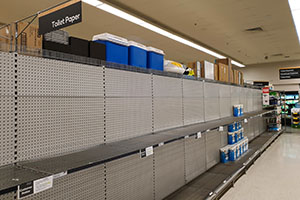The global supply chain has experienced once-in-a-lifetime disruptions — at least four times in the past 12 years or so. The 2007-09 financial crisis was followed by Japan’s tsunami, earthquake and nuclear disaster of 2011, which was followed by the U.S.-China trade conflict that seemed to peak in 2018 and now the COVID-19 pandemic.
Resilience, once a hallmark that academics ascribed to the most successful supply chains, has become a “matter of survival,” writes an international team of researchers including an expert from Olin.
Why do some distribution businesses have it and others don’t? It’s all about the implementation and execution of resilience strategies, the team learned from supply-chain executives and shared in a paper forthcoming in Management and Business Review.
In a series of pandemic-era interviews with 14 senior executives from 12 companies representing a wide range of industries affected by the pandemic, the co-authors discovered that the businesses survived, if not thrived, due to “agile responses”—whether for the short term or long term, or both. These interviews allowed the researchers to derive an integrative framework similar to a how-to list, split into two basic categories: enablers and resilience strategies.
Enablers and resilience strategies
The resilience strategies are built upon policies that increase redundancy and operating flexibility: operation buffers (such as different inventories); footprint diversification (postponing or relocating production lines); supply options (flexible networks and financing); robust distribution (alternative warehousing, transport and routes); product standardization (sharing components or using off-the-shelf parts); and partner network (supplier relationships and sharing risks, costs and gains).
The enabler activities essentially are best practices and “prerequisites for implementing the strategy elements,” the researchers wrote: end-to-end visibility, end-to-end control, continuous IT infrastructure, and organizational readiness (previous or continuous risk management and planning).

“While all executives seemed well-versed into the supply chain resilience theory and concepts, they all discussed the implementation barriers they encountered as they tried to move their company’s supply chain to a needed resilient state,” said co-author Panos Kouvelis, director of the Boeing Center for Supply Chain Innovation and the Emerson Distinguished Professor of Operations and Manufacturing Management at Olin. “The executives were quick to point out supply chain resiliency as the attribute to guide the companies’ adjustment in the new (ab)normal world we will face the next two years.”
Kouvelis and his co-authors— rom Stanford University, Georgetown University, Santa Clara University, Kobe University, Germany’s Otto Beisheim School of Management and the University of Pennsylvania—followed four themes in their interviews: How has your company responded to the crisis? What are the elements of your resilience strategy? How did you arrive at that strategy? What lessons are key moving forward?
Cisco, Colgate-Palmolive, Nike, etc.
They interviewed executives with firms anywhere from a 2,000-employee food business in Asia earning $2.5 billion annually to a 150,000-employee consumer products company in Europe earning $52 billion annually. Among them were Cisco, Colgate-Palmolive, HP Enterprise, Infineon, Nike, Unilever, Emerson and Bayer Crop Science.
The co-authors learned that these companies basically designed a resilient supply chain via a two-stage process: selecting the “right” fit of strategies—and nobody implements all of the aforementioned—and then defining how to implement them. This could mean that, in the definition process, company management decides their first choice proves to be unfeasible or costly and instead opts for a Plan B. A company may also design different strategies for different products under their umbrella.
The researchers also found that strategy implementation, in these times of outsourcing and global disruptions, was enhanced by a collaborative, cooperative relationship among logistics businesses, suppliers and customers.
Interestingly, the researchers learned that executives are more willing to invest in resilience strategies if they had trouble regaining their market position after a disruption. For instance, it was mentioned amid the interviews—as examples of best practices—how Japanese automakers invested in increased buffers to reduce disruption risks after the 2011 earthquake, and Cisco reviewed its supply chain network to assess suppliers’ financial health after the 2007-09 crisis. The expenses were justified as a long-term and cost-effective “insurance policy.”
In fact, cross-company collaboration was seen as a necessary cost to the point where some companies financed suppliers and buyers, or at least provided technical support, to ensure a stronger supply chain.
‘Prescriptive recommendations’
The researchers offered a list of “prescriptive recommendations” such as centralizing the risk-management function, strengthening supplier relationships and innovative financing. However, they noted that the more resilient companies react early in such a crisis, and chains’ designs differ as much as their products, markets and countries. In other words, what works for toilet paper in Texas won’t work for cars in the Cayman Islands.
Kouvelis said he heard clear echoes of “never let a good crisis get wasted” throughout the executive interviews, and he paraphrased one of them: “You might even consider it a blessing in disguise … .” That particular company used the pandemic disruption to speed up digitalization of its supply chain and invest further in risk management.
In a separate paper written by Kouvelis and Morris A. Cohen, the Penn researcher from the resilience strategies study, and accepted for publication in the Production and Operations Management Society (POMS) journal, the co-authors rewrote the long-held Triple-A framework of successful global supply chains: agile, adaptable and aligned. They re-evaluated and reconfigured it, adding three R’s in addition: robust, resilient and realigned.
The reasons behind the redo are the global crises and the localized shocks that regularly have arrived the past decade-plus: Industrial supply chains have been found to experience a serious, one-month disruption every four years or so.
“The Triple-A framework of supply chain excellence served us well in the 1990s and early 2000s,” Kouvelis said of the rationale for, and the logic of, a new framework. “However, the last 15 years have seen frequent supply chain disruptions—and of alarming severity. Time to add the R’s in the supply chain excellence attributes model.
“Short-term agility has to be complemented with robustness for real-time responses across a wide range of scenarios. Adaptability to long-term technology and macroeconomic trends needs resilience to future shocks and the new (ab)normal world. Moreover, alignment of incentives of existing supply chain partners requires realignment to deal with evolving business models, changing consumer needs and preferences and a newly defined value system. The era of turbulence of the next 20 years needs a Triple-A-&-R portfolio of excellence capabilities in supply chains.”
POMS honored Kouvelis in its November 2020 issue, printing a career commendation called a Laudatio (subscription required). POMS also published as the lead article in that issue a study by Kouvelis and a Chinese University of Hong Kong professor on distribution channel compensation, initially posted online in June.





Thank you so much to share this article with us. I really enjoyed your article. Keep us updating.